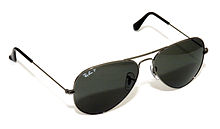Ray-Ban
Ray-Ban ( German : Radiation Protection ) is a brand of sunglasses and prescription glasses. It was founded in 1937 as a subsidiary of Bausch & Lomb , a manufacturer of medical optical devices with the participation of the United States Army Air Corps (USAAC). The first prototype anti-glare was applied for a patent on May 7, 1937. In 1999, Bausch & Lomb sold the brand to the Italian Luxottica group for $ 640 million .
history
The history goes back to the 1920s. At that time it became possible to fly higher and higher with airplanes. Many US Army pilots have reported that the sun glare gives them headaches and nausea. In 1929, Lieutenant General John MacCready commissioned the Rochester , New York- based manufacturer of medical optical devices Bausch & Lomb to develop aviator goggles that were supposed to relieve nausea and headaches caused by the intense blue of the sky and the sun's rays. In 1936 a first prototype, called Anti-Glare , was made, which had a plastic frame and green glasses. In 1937 this prototype was redesigned and got a metal frame, and the Ray-Ban Aviator was born . Bausch & Lomb was awarded the patent on May 7, 1937.
In 1939 the product range was expanded to include the Outdoorsman , a modified form of the aviator for use outside the aircraft. These glasses had a sweat bar - a temple which was supposed to prevent sweat from running into the eyes. In 1952 the Wayfarer followed , which was equipped with the G-15 glasses that were to become the standard from 1953. These consist of mineral glass and are thermally hardened. They are green-gray in color with 15% light transmission. Other models followed, including the Olympian 1965 and the Olympian II . Several models came onto the market in the 1990s, but they couldn't stop Bausch & Lomb from stumbling. Competitors like Oakley became particularly popular among the younger group of buyers, so that Ray-Ban was finally sold to Luxottica in 1999 for US $ 640 million . Luxottica continues the Ray-Ban brand.
Identifying features
Original Ray-Ban glasses have some distinctive features. A small BL is etched into the edge of each lens , in addition to which the writing Ray-Ban can sometimes be read on the right lens . The BL can also be found on the nose pads. B&L RAY-BAN USA can be found on the bridge between the lenses , in the long form Bausch & Lomb RAY-BAN USA this is also printed on the inside of the right arm. The inside of the left temple is often, but not always, marked with the model number. With the Wayfarer model, the model number is located on the inside of the frame above the right-hand lens, and with this model, RayBan was only printed on the right-hand lens with the introduction of the Wayfarer II sunglasses. With these old Bausch & Lomb models, the type designation is usually on the inside of one of the two ear hooks.
The newer versions of Ray-Ban glasses have slightly different characteristics. So instead of “BL” there is only an “RB” engraved in the left lens. Between the two glasses there is only the brand name "Ray-Ban". The brand name is shown first on the right bracket and next to it “Made in Italy”. The model name and number are on the left bracket. What remains is the obvious “Ray-Ban” lettering in the upper left corner of the right lens.
There are also other symbols and letters that were printed on the right lens or written in the left temple. A diamond on the right lens means that the lenses have been specially coated and are scratch-resistant like a diamond, a P or P3Plus means that the lenses are polarized, and "Polarized" is also written on the left temple. In addition, there are other text variations on the left and right arm in Special Editions.
Entry into culture
Ray-Ban sunglasses found its way into some movies, known examples are the Wayfarer in Blues Brothers and the television series Miami Vice or Club Master in Rainman and Malcolm X .
Spectacle lenses
- B-15: Standard lens for aviator goggles, 85% light absorption
- G-15: Standard lens, low contrast and more natural color representation, 85% light absorption
- G-15 XLT: 14% lighter standard eyeglass lens, low contrast and more natural color representation, 85% light absorption
- Polarized lenses that block reflected light
- Phototropic lenses that darken under UV light
- Gradient: lenses with a gradient that are only partially darkened. Developed for better visibility of instruments in aircraft
- Amber colored glasses that adapt their color to the weather. Developed for winter sports
Web links
Individual evidence
- ^ Company News: Bausch & Lomb Selling Sunglass Business to Luxottica . In: NY Times , April 29, 1999. Retrieved September 5, 2010.
- ^ Men's Health
- ↑ The Gentleman's Topcoat ( Memento of the original from October 12, 2014 in the Internet Archive ) Info: The archive link was inserted automatically and has not yet been checked. Please check the original and archive link according to the instructions and then remove this notice.
- ^ Ray-Ban: The History of the Top-Selling Eyewear Brand Worldwide . Luxottica . Retrieved October 14, 2013.




